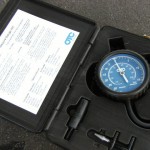 One of the easiest and cheapest ways to check an engine for serious issues is to use a plain ole vacuum gauge. A vacuum gauge can tell you a lot about an engine's condition, similar to a full leak down test - but in a much easier way. In just 3-5 minutes you can know if an engine is healthy or not.
One of the easiest and cheapest ways to check an engine for serious issues is to use a plain ole vacuum gauge. A vacuum gauge can tell you a lot about an engine's condition, similar to a full leak down test - but in a much easier way. In just 3-5 minutes you can know if an engine is healthy or not.
For those of you modifying your engine, I think it makes a lot of sense to make sure your engine is in top notch shape before spending money on modifications, especially if you're working on a high mileage car. Making sure the engine is making at least stock horsepower before you spend more money on it is a very sensible thing if you ask me.
Vacuum gauges are often forgotten in this age of OBDII scanners and other specialized tools, but a vacuum gauge can VERY quickly tell you whether or not your engine (or one in a car you're about to buy!) is good, or ready to die.
Before I get started I should note that it's good to use a vacuum gauge to 'test' a few known good engines in your area before testing a suspect engine. The reason is that while the basic ranges and procedures described here are pretty accurate for most situations, EVERY location is different due to altitude and other factors. Therefore, while I might get a 20 inHg reading on a healthy engine in my area, you might only get 15inHg on the same engine due to altitude, for example.
Tip: Periodically checking your engine vacuum will help you learn how your engine is doing and allow you to spot behavior out of the norm.
 To check an engine with a vacuum gauge, all you need is a vacuum gauge (duh) and a bit of vacuum hose. There are some great kits for the purpose for sale online. I personally own this one by OTC tools which was about $40 shipped to my door. There are cheaper ones and there are also more expensive ones - just about any will do though.
To check an engine with a vacuum gauge, all you need is a vacuum gauge (duh) and a bit of vacuum hose. There are some great kits for the purpose for sale online. I personally own this one by OTC tools which was about $40 shipped to my door. There are cheaper ones and there are also more expensive ones - just about any will do though.
As a bonus, it can also be used to measure exhaust back pressure (if the gauge also measures positive pressure) - but we'll talk about that another time.
To test the engine, start it and let it reach full operating temperature. Then simply connect your vacuum gauge to an empty vacuum port on the intake manifold (anywhere PAST the throttle body).
You may need to T a vacuum line, which may or may not have come in your kit.
Once you've connected the gauge you should see a STEADY reading at idle with the throttle closed. That reading should be between 17 and 22 inches of Mg (mercury).
1 inch of mercury by the way is a measurement that is roughly equal to 0.491 psi.
A high, steady vacuum reading is the sign of a healthy engine. If you're at altitude, these readings may be lower (supposedly by 1 inch of mercury for each 1000ft above sea level, roughly). A low vacuum reading means you have poor piston rings or oil rings. You may also note lower vacuum readings when running high overlap camshafts or changed camshaft timing.
If the engine passes that test then snap the throttle open and closed again. Doing this quickly should reveal a vacuum drop to perhaps 0-3 or so and then it should snap back to 25 before settling back to 17-22 again. This means the valves and rings are OK.
Example Video:
Snapping the throttle and getting a drop to 0 and then a climb to only say 20-22 will possibly indicate worn rings. Basically, if it only snaps to about where it was or just a hair above, you may be dealing with worn piston rings. It should snap temporarily higher (3-4 inches or so) and then settle back.
A sticky valve can be spotted by seeing a vacuum reading that occasionally drops from normal by about 4 inches of mercury.
A burnt valve will behave the same as a sticky valve, but will drop much more, say 6 inches of mercury (and then return back to normal, in a cycle).
Worn valve guides can be detected by a vacuum reading that vibrates back and forth between 14 and 19 or so very quickly.
Weak valve springs if you suspect weak valve springs, rev the engine to say 4000 rpm and see if the needle swings back and forth rapidly. Then raise the revs to 5000 or even 6000 rpm, if your valve springs are weak, you'll see the swinging get wider as revs increase.
A vacuum leak would be indicated by a low reading of say 5 inches of mercury or so. Though, a very low reading can be caused by extremely advanced ignition timing or incorrect camshaft timing as well.
Headgasket issues can be found by seeing a floating needle between 5 and 19 inches of mercury. This could also be caused by a intake manifold gasket leak or a faulty injector. You can check the oil for coolant if you see this behavior however (and vice versa) to confirm your diagnosis. Oil can be tested for coolant since it'll be impossible to see in it.
Really strange behavior such as a vacuum indication that shows a slow movement between various readings could mean a leak in the intake manifold, bad idle air/fuel ratio, or perhaps a clogged PCV system.
You can also use a vacuum gauge like this to see pressure drop in your intake, though, I prefer to use a more sensitive tool/gauge for that as the vacuum in the intake system at WOT is hopefully very, very low. More on that in an upcoming article
Vacuum gauges like this can be used for dozens of projects and if nothing else, it's a great tool to use to quickly check out a used car's engine before buying it. Obviously, if you see from the vacuum gauge that there might be a worn head gasket, rings, or anything else - you'll save yourself a ton of headaches down the road.
While vacuum gauge readings do not necessarily tell you with 100% certainty what the problem is, what they CAN do is tip you off that something certainly IS wrong, and it's probably expensive.
In a later article, we'll talk about another great way to test the health of your engine and get an even better idea of how well it has worn over the years - testing your oil.
Extremely Limited Time Offer - 3 Days Only
Get a MASTERS DEGREE in Performance Tuning from the BEST in the Field for ONE low package price
For 3 days only, get ALL of our PREMIUM (not available anywhere else) Tuner University Courses featuring some of the greatest minds in motorsports:
- Top 10 Performance Myths Class (MP3 and Edited Transcript) - $29.95 value
- Performance on a Sip of Fuel Class (MP3 and class manual) - $69.95 value
- Header Design Secrets with John Grudynski (MP3 and transcript) - $69.95 value
- Dirty Secrets of Oil with Ryan Stark (MP3 and transcript) - $69.95 value
- Engine Tuning Secrets with Ben Strader of EFI University (MP3 and Transcript) - $69.95 value
Get all of the above courses (many of which not currently available anywhere else) for one single price of just $309.75 $69.95. A HUGE package savings.
You can also buy any of these individually through our resource center, but I don't know why you would as this is basically the whole store for the price of just 1 course. You'll get the MP3 recordings of each class as well as a transcript or companion manual with each course and you'll be able to download them all INSTANTLY.





